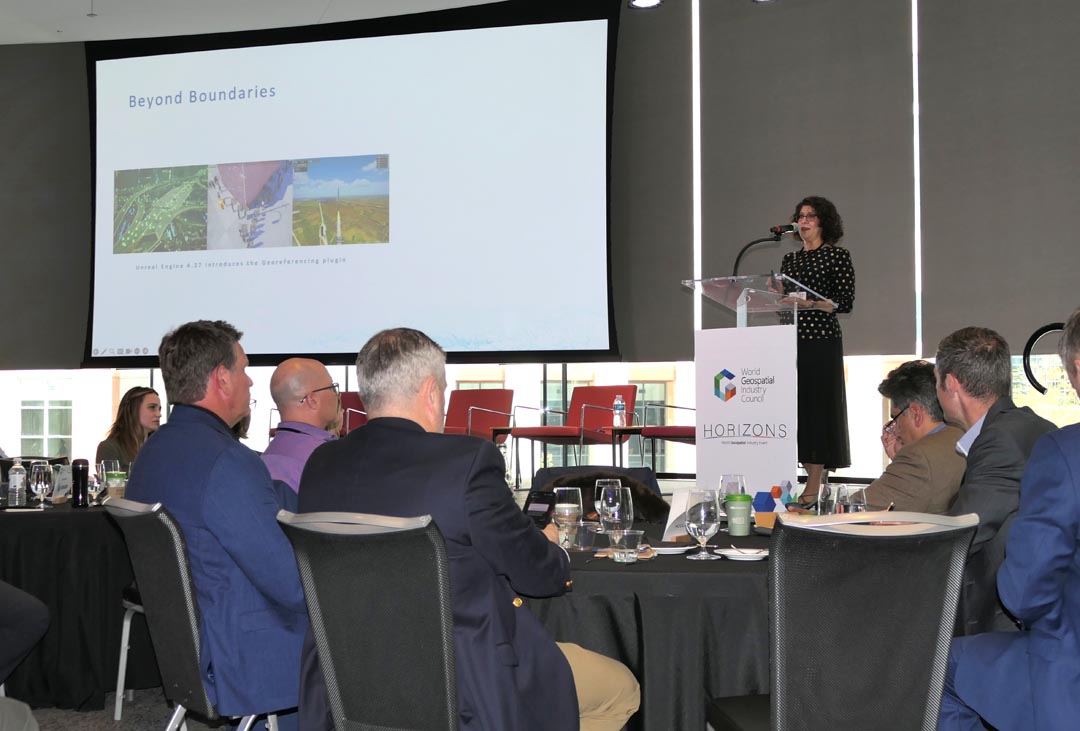The World Geospatial Industry Council (WGIC) brings together companies from across the geospatial sector to promote innovation, share industry perspectives, and encourage the use of geospatial technologies to tackle global challenges like sustainability, climate resilience, and economic development. Last week, they hosted their first-ever in-person event - WGIC Horizons - with the goal of bringing together WGIC members and industry leaders together in a conference with opportunities for networking and discussion.
The conference featured a single-track of content, featuring pairs of back-to-back talks followed by fireside chat style panels, with lengthy networking breaks in between each set. This format allowed for more than just a refresh of one’s coffee in between sessions, and helped attendees to be able to network or follow up with speakers.
While the topics were wide-ranging - from generative AI to building urban resilience to climate change - the content felt like it had underlying connections and themes throughout. There are many issues that are facing the geospatial industry and its workforce, and the presentations and discussions touched on the disconnection between some areas of geospatial and other challenges ahead, as well as celebrating the potential of new applications and processes. Below are a few key takeaways from the content and comments presented.
The (lack of) workforce is on everyone’s mind
As we’ve covered on Geo Week, the geospatial industry is facing a significant workforce crisis, with demand for skilled professionals far exceeding supply. As Bryn Fosburgh from Trimble put it, "It's very difficult today to get a surveyor. It's very difficult to get somebody who's a cartographer or a geospatial professional, super hard".
Research presented at the conference showed an alarming gap between the growth rate of geospatial jobs and the number of qualified graduates that universities can produce. This shortage is particularly concerning as the current workforce ages, drawing a parallel to similar challenges in technical fields, like COBOL programmers, etc..
At the same time, the nature of geospatial work is evolving dramatically, shifting from a vertical specialty to a horizontal skill set needed across multiple industries. Aaron Addision of WGIC emphasized that this transformation requires professionals with not only technical expertise but also soft skills rarely taught in traditional programs. Employers are increasingly seeking candidates who can handle data wrangling, understand legal and ethical implications, and communicate complex concepts to non-technical stakeholders.
Addressing this workforce challenge requires collaborative efforts between industry and academia, says Addison. The consensus was that success will come from embracing diversity, promoting lifelong learning and helping students understand the real-world impact of geospatial work rather than focusing solely on technical tools that will inevitably change throughout their careers.
In AEC, technology adoption still has some hurdles
As we’ve heard from many areas of reporting, there are some industries that have historically lagged in technology adoption. José Luis Blanco, Senior Partner, Global Leader of Engineering, Construction and Building Materials at McKinsey & Company spoke to these challenges in construction, and asked in his talk, “Is technology innovation in construction really taking off?”
The presentation focused on technology's transformative potential in the construction industry, highlighting critical challenges like massive labor shortages and unprecedented demand across sectors. The industry faces a significant labor shortage, with 45% of the workforce expected to retire in the next 10 to 15 years. Blanco emphasized that while technology adoption is progressing, it's still limited to about a 9% growth in adoption.
“Now the question is, is 9% a good number, or should it be 50%? That's a different story... With all these conditions, all these constraints that we're operating at - 9% is pretty good. But if we were able to alleviate some of the constraints on some of these areas, we would probably be looking at more.”
With key barriers including risk aversion, zero-sum contract dynamics, and insufficient workforce upskilling. Major trends include the need to shift from control-focused technology to value-creation approaches, with AI and digital tools offering promising solutions to productivity challenges. The industry must prioritize upskilling workers, creating innovation-friendly cultures, and implementing practical technological solutions that directly improve project efficiency, says Blanco.
"Construction was never cool, let's face it. But with technology, over the past few years, we get an opportunity to get people excited about applying technology to transform the industry in ways that haven’t happened before."
AI “agents” are coming to help with all that data
Several speakers, including Sean Young, Director, AECO, Geospatial, and AI Solutions Industry Marketing at NVIDIA, touched on the potential for AI “agents” to be utilized in geospatial applications (known as “agentic AI”). This would enable a shift from passive tools that analyze data to active systems that can plan, decide, and take action within complex spatial data environments. Young explained that agentic AI involves autonomous AI agents operating and communicating with each other without human intervention. He provided an example of construction site safety monitoring, where AI could predict potential accidents by analyzing crane movements and worker positions, then autonomously take action like alerting operators or stopping machinery automatically.
While this is still something seen as far out on the horizon, these emerging AI agents have a lot of potential, especially in an industry that continuously collects massive amounts of data and creates digital twins of real-world situations. By connecting systems together to take input from several sources and make a decision, workflows could drastically change. This evolution could accelerate how geospatial challenges are addressed, opening the door to faster, more adaptive, and more scalable solutions across industries (even if the thought of it feels a little sci-fi).
Geospatial needs to be “in the room where it happens” for AI
In a memorable talk, Nadine Alameh, Ph.D., Executive Director of the Taylor Geospatial Institute, traced the evolution of the geospatial ecosystem from the mid-1990s — when tools like Esri, GeoMedia, and MapInfo required complex XML skills — to today’s cloud-native, AI-integrated landscape. She highlighted the shift from siloed, specialist geospatial tools to more accessible, low- and no-code platforms that integrate spatial data with broader technologies, helping to democratize spatial analysis.
Yet, Alameh voiced a critical concern: despite these technological leaps, the geospatial community remains underrepresented in key AI policy discussions. While major tech players like Microsoft, Google, and AWS (all present at the conference) are actively shaping geospatial AI tools, geospatial experts are too often absent from the conversations that shape AI policies and foundational models.
Closing the event, outgoing WGIC President Bryn Fosburgh reinforced this point, warning that the industry’s fragmentation threatens its future. “Our strength is our diversity — culturally, racially, in gender, geography, and belief — and that diversity fuels the many solutions we bring to the table,” Fosburgh said.
“But it’s also our weakness. We are very fragmented as an industry… There’s great opportunity for all of us, but it has to happen through collaboration. Collaboration is key — because our fragmentation is killing us.”
What's next?
The WGIC Horizons event ultimately left attendees with both inspiration and a challenge. While the sessions showcased exciting advances — from the rise of agentic AI to the growing democratization of spatial tools — the deeper message was clear: the geospatial industry stands at a pivotal crossroads. To meet the demands of a rapidly changing technological landscape, tackle a critical workforce shortage, and ensure geospatial voices are part of shaping the future of AI, the industry must break down its silos and commit to true collaboration. As speakers throughout the event emphasized, the opportunities are vast, but realizing them will depend on the geospatial community’s ability to work together, amplify its influence, and ensure it has a seat at the table in the global conversations ahead.






